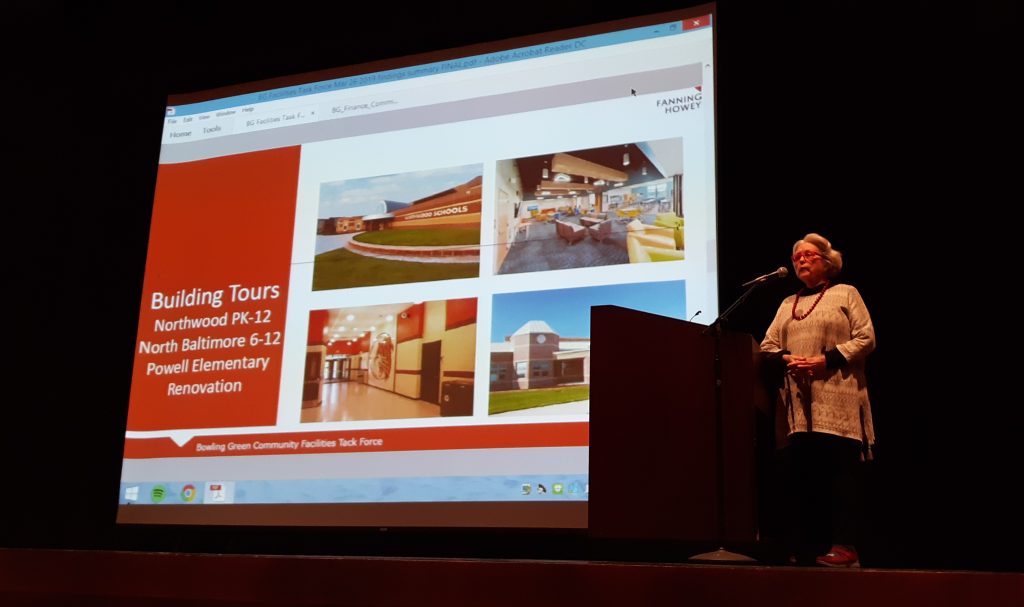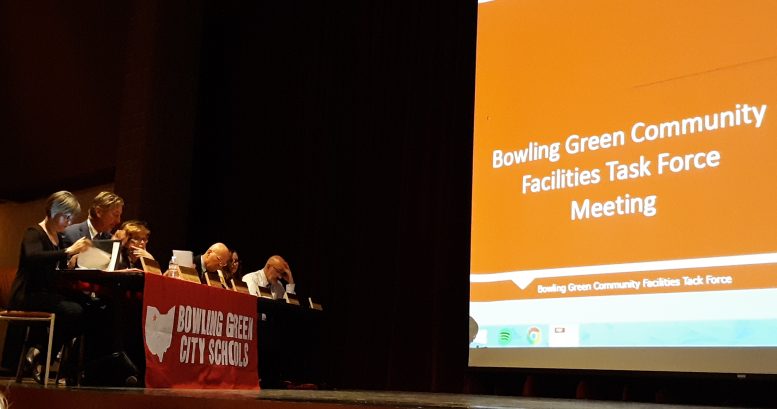By JAN LARSON McLAUGHLIN
BG Independent News
Bowling Green voters want to support their schools – they just need to see the right plan with the right funding, the board of education was told on Tuesday evening.
After seven months of lengthy meetings, school tours and tax calculations, the task forces charged with coming up with a solution for the district’s buildings presented the plan they think voters will support.
“The community, I believe, wants to address this issue,” Ben Otley, a member of the finance task force said during the presentations to the board.
The top recommendation calls for the school board to construct new elementary buildings at Conneaut and Kenwood, and renovate plus expand at Crim. The proposed funding calls for a $40 million issue spread over 30 years, with half raised through property taxes and half through traditional income taxes.
The task force suggested that the board put the issue on the ballot this November.
The last two bond issues on the ballot – for a consolidated elementary school completely funded through property taxes – were soundly rejected by voters.
This proposal is a true compromise – with the task force members hoping to win over the people supporting neighborhood elementaries, and the agricultural community opposed to the entire cost being paid through property taxes.
“Nobody got everything they wanted,” explained Tracy Hovest, a member of both the facilities and finance task forces. “Nobody can say they didn’t have their opinion heard.”
The next move is now up to the school board.
Board of Education President Ginny Stewart expressed her thanks to the more than 100 community members who worked on the task forces.
“I know that the board is extremely grateful for their work,” she said, calling the presentations Tuesday evening “very thoughtful and insightful.”
“Your commitment to our schools, our students, and our teachers has not gone unnoticed,” Stewart said.
The board is meeting for a special work session on Saturday at 9 a.m., to further discuss the task forces’ reports.
“Now the task is up to the board to make a decision what we’ll go to the public with,” Stewart said.
Superintendent Francis Scruci also expressed his gratitude.
“The community did a great job. The board has to make a tough decision,” he said.

The report from the facilities task force was presented by members Tim Parish, Joanne Navin, Frances Brent and Wayne Colvin.
The facilities group toured Bowling Green’s three elementaries plus the high school, and traveled to Northwood to tour a new school and to North Baltimore to visit a renovated elementary.
Parish mentioned that the first meeting of the task force was held in the high school cafeteria, when the temperature was above 90 degrees. Navin described the “eye-opening” tour of Kenwood, which was new when her children attended school there. And Brent told of the “pride and happiness” voiced by the Northwood and North Baltimore superintendents about their new and renovated buildings.
Colvin described some of the conditions at Bowling Green’s elementaries.
“One teacher’s space to teach a student was in an old custodial closet, and the custodial sink was next to her desk,” he said.
Another teacher’s space was the stage in the gymnasium at Conneaut. And at Kenwood, the floors in one classroom were hot. “The steam pipes were leaking so bad,” he said.
Though some task force members favored renovations rather than new buildings, Colvin said problems like the heating system at Kenwood cannot be resolved unless the building is “taken down to bare bones.”
The majority of the facilities task force members consistently supported a consolidated elementary – both for educational and operational reasons. However, the members compromised “to actually get a levy passed and something built,” Parish said.
When asked to vote based on projections of community support, the task force ranked the building options in this order:
- Build new Conneaut and Kenwood elementaries, plus renovate and expand Crim Elementary, with an estimated cost of $37 million.
- Build a new elementary possibly on the site north of the middle school, plus renovate and expand Crim, costing $34 million.
- Renovate all three elementaries, costing $32 million.
- Build one consolidated elementary, costing $40 million.
Those estimated costs include construction, design, architectural work, testing, inspections, project management, plus furnishings and technology for the buildings.
Once the facilities task force came up with a proposal, it was then up to the financial task force to figure out how it could be funded. The task force, with more than 40 consistent members, represented a cross section of the community, Otley said.
They studied local home values, average incomes, types of taxpayers, tax rates compared to other school districts, the possibility of state funding, tax options, and the district’s financial forecast.
Hovest said she was not a “numbers person,” but became one after months of task force meetings.
The financial task force came to a strong consensus that the best funding route for school buildings was a combined property tax and traditional income tax. By shortening the length of the bond issue to 30 years, the district can save $7 million in interest.
The task force asked that the building issue go on the ballot soon – this November.
“Time is of the essence, especially with the condition of our buildings,” Hovest said.
The proposed 1.76-mill property tax would cost the owner of a $100,000 home an estimated $5.12 a month. The proposed 0.25 percent income tax would cost a person with an average income of $66,215, another $13.79 a month.
The task force also asked that any additional funding raised by the tax revenue should to be used for permanent improvements to maintain the elementaries.
The financial task force also suggested that the school board apply for state school funding through the Expedited Local Partnership Program. Bowling Green’s ranking for the funding means it will be at least 10 years before money might become available.
“There are a lot of ‘ifs’ with this program,” but there’s no downside to applying for the funds, Otley said.
Board member Paul Walker asked if the task force members had suggestions on how to get information out to voters.
Hovest said that the community members who invested so much time on the task forces will likely step forward to help spread the word.
Otley said he believes the community is waiting for a solution.
“This community needs to move forward and take care of our schools,” he said. “They want to do the right thing and support our schools.”
Board member Bill Clifford mentioned the last two efforts on the ballot.
“It failed miserably, especially the last one,” he said. “We thought we had the best laid plans, but the community said, ‘No.’”
Otley agreed the task force members would be well prepared to explain the issue to voters.
“Use us in the community to get the word out,” he said. “We’ll get the correct information out there,” and respond to any false information spread.
“When misinformation is put out in the community, it has to be addressed and the correct information has to be put out there,” Otley said.
Board member Jill Carr asked the task force members if they discussed building solutions for the high school. A high school renovation and addition were part of the initial building proposal that was rejected.
“We looked at it and kind of wept,” Brent said of the condition of the high school. “Let us not forget the high school. But I know we can’t do everything at once.”

